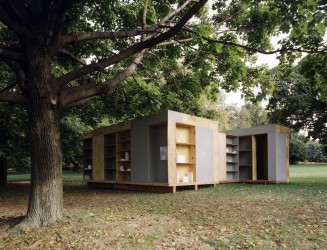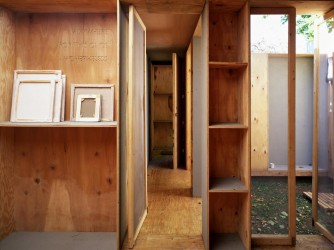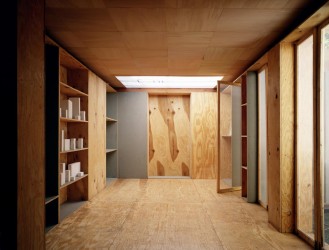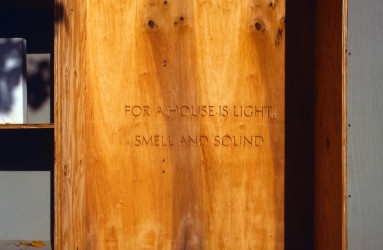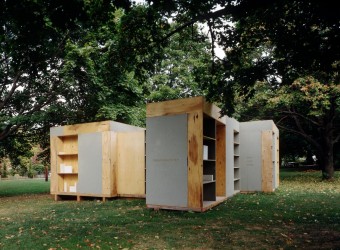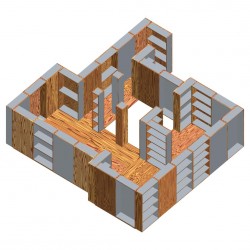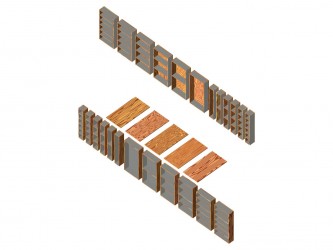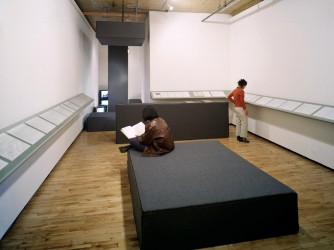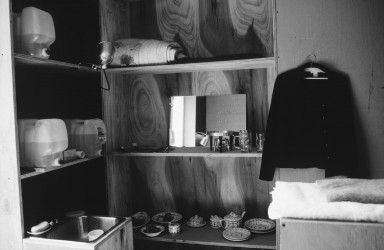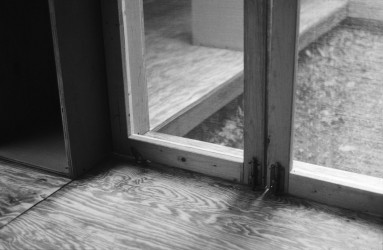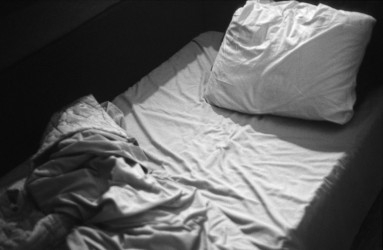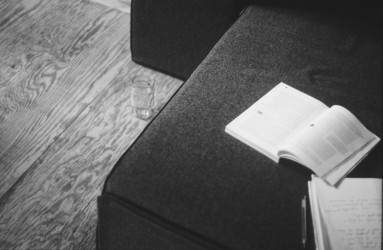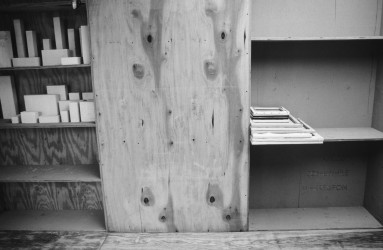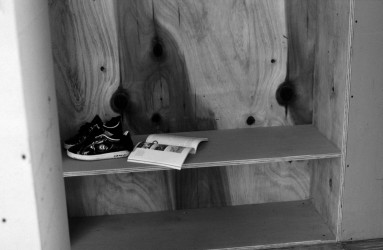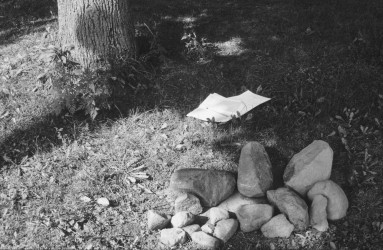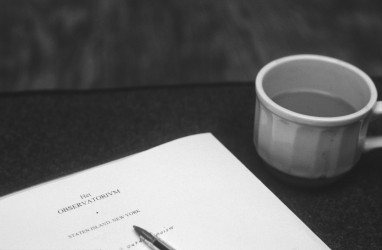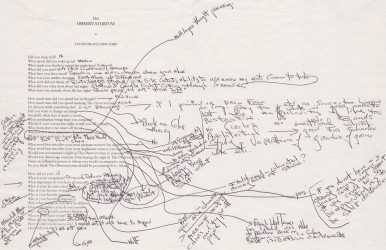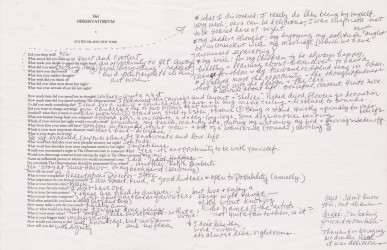45 people each stayed for 24 hours in a sculpture consisting of modular bookcases in the public park, and left a record of their reflections, which were on view in an art gallery.
TIME AND SPACE FOR FOCUSSING ATTENTION
Art needs a spectator. Creating time and space for focussing attention means giving, through the work of art, ample time and space to the spectator. The exhibition space takes on the nature of a dwelling, an opportunity for meaning to arise in the course of a prolonged, uninterrupted stay.
Time
Following 24 hours spent in isolation, Mary said, "I need to do that more often in my life, to take big pieces of time." Why has the wish to make sculpture that commands big pieces of time developed into such an important theme for Observatorium? Dwelling for Seclusion, a pavilion erected in the gardens of Snug Harbor Cultural Center on Staten Island, New York City, arose from the desire to place art at the service of an individual experience of quietness, seclusion and prolonged observation. This time it was in a dedicated domain instead of an art gallery.
A six-month artist-in-residency enabled the group of three collaborating artists (not yet formally known as Observatorium) to address the three ingredients – space, time and attention – with precision and wholeheartedness. Space was no longer confined by the walls of a gallery, but was now provided by an isolated building in rural surroundings. Time was no longer limited to exhibition opening hours, but was marked by the rising and setting of the sun. And the guest's recorded thoughts about the work and the situation were not only collected or read out, but formed exhibits in an art gallery.
Pilgrimage
A New Yorker wrote about the journey from his Manhattan home to Dwelling for Seclusion as follows. "I took the ferry across the river. Once on Staten Island, walked along sidewalks which became increasingly dilapidated the further I travelled from the centre. Then I reached the fence of Snug Harbor and entered the grounds. I had left the city, the roads and the buildings of the complex behind me, and here was this wonderful Dwelling for Seclusion." His detailed travelogue could easily be interpreted as a pilgrim's tale: leaving the city, crossing the water, entering a domain, leaving everything behind and finding quiet and solitude. What he did not know was that Observatorium's design was an outcome of their study of the architectural theories published by the Dutch monk Dom Hans van der Laan.
Articulation of space
Van der Laan's book Architectonic Space influenced two features of the Dwelling for Seclusion: the articulation of space, and the proportions of the fabric. The guest had crossed several boundaries in progress from the everyday world, and the building had boundaries of its own. Entering the core from outside involved stepping up from the surrounding field onto the platform where the pavilion stood, and going into the entrance hall. From the hall, the guest went through the door into the corridor and along it to the main space. Behind that lay the cell-like room and the kitchen. The kitchen adjoined an open courtyard which provided some contact with the park the guest had just left behind. In many respects it was like a one-person cloister, with three rooms surrounding a courtyard: a kitchen, a toilet, a bedroom and a studio. It was a variant on Van der Laan's articulation of a building into a cella, court and domain, and it resembled the only house Van der Laan ever built. That house, Villa Naalden in Best, has been described as "a classic dwelling around a courtyard, fringed by groups of piers and with a small, articulated hall as a living room."
Proportions
The bookcases share the attributes of all Observatorium's structures. They are modular, simple, multi-purpose and, despite these pragmatic attributes, rich in symbolism. The construction method is simple, lightweight and inexpensive, making it possible to erect pavilions or other structures which are stable. It has the symbolism of a mental space – an empty library (the promise of knowledge) with room for the user to fill the shelves with his own experiences and insights. The bookcase is a serendipitous invention, a discovery not deliberately sought after. The wall, in Van der Laan's architectural theory, is a human artifact that Observatorium uses to enclose and exclude space. The thickness of the wall is as much a part of a house as the space it circumscribes. In the monk's harmonious architecture, the refinement of the proportions is visually obvious, and the wall thickness that is visible around windows and doorways is an intrinsic part of the dimensional relationships. Quite a few of Van der Laan's buildings have walls that are 40 cm thick. How could we apply thickness of this order in a little pavilion? Obervatorium's conclusion was to make the walls effectively hollow. For a hollow wall to be sufficiently rigid, it needs transverse members; and that led to the idea of a bookcase. The quest had been for a structural solution, yet the outcome was sculptural symbolism: a house awaiting knowledge.
Moreover, the shelves opened inwards in some places and outwards in others; the latent library was an exterior as well as interior phenomenon.
A hut of ones own
The New York guests were invited to take up residence in an empty library and to fill the shelves with their own findings. One by one they became part of a freestanding sculpture with a human being in it. Visitors walked gingerly around the bookcases, cautious about disturbing the resident hermit. The photographs, drawings, films and texts that were left behind were taken to the Manhattan gallery Art in General and exhibited there. The gallery space was divided into two by a wall of bookcases. A rotating bookcase gave admittance to the Reading Room with Collected Reflections.
Here, too, it was left to the individual visitor to close the door and give himself or herself over to perusing the reading matter in solitude.
Textual environment
The bookcases had texts engraved, providing time and space in words. Moving around inside:
Anywhere
For this once
Nonetheless
Amidst
Somewhile
Whereupon
Thereabout
Nowadays
Allthemore
Nowhere near
Whencesoever
Thereby
Moving around outside:
Entrance:
AΩ
Count your illusions
West:
[...]
(sic)
North:
Loyal to your observations
in the presence of darkness
After departure for transit
afttermath is prepared
As I
not man, but it
East:
One's own skeleton
South:
What How Where
Thousand and one
For a house is light, smell and sound
The gentle art of settling
"You have gold dust on your hands", an American friend of Observatorium remarked; the artists had tapped into a rich vein of potential imagery. The work attracted the attention of the New York art world, was warmly reviewed in the New York Times and was the subject of a long personal reflection by one of the residents which was published in the architecture and design magazine Metropolis. The Dwelling for Seclusion was continually occupied by one guest after another (indeed, it was almost sold), and offers of further exhibitions followed. All in all, it was not bad for a group of artists just starting out. But success in the context of the art world was not what prompted the three artists to found Observatorium as a collective when they returned to Rotterdam; it was the discovery that their shared predilection for space, and the opportunity to create relative freedom in the park, allowed them to create a world model in miniature, a microcosm of human interaction with the environment.
Henceforth, the focus would no longer be on making objects or on proposing ideas, but on participating in the culture of dwelling. The work was about settling the earth, about pioneering, making places and creating space – not space to live or to work, but to play, ponder and daydream. An "observatorium" would not be a scientific facility for studying the cosmos, but a place dedicated to our perception of the world and the human place within it.
The Dwelling for Seclusion was a rewarding experience for the guests, rather than being a sellable work of art (or however one might describe it). The guest experienced the absence of the self in an inland sea of time. Not one guest discovered himself or the Other in himself; everyone described it in terms of such phenomena as warmth, wind, comfort, emptiness or time – free time. The availability of 1 part space plus 1 part time prompted a sense of gratitude. Many guests thought mistakenly that it was an act of generosity on the part of the artists.
Preconception of a box
A friend told me she had something exciting to tell me. Then she walked away. This was the first time I heard of Observatorium. Later, she said it was this place to go and stay overnight, for twenty-four hours. There are no windows and no furniture, some furniture maybe, but it's sparse, a couple of padded blocks, and these artists made it, and the idea is that you stay here in isolation for a night, a day and a night, it's about introspection and you will just love it, I really think you should do it, you would love it. I asked if it was some room within some building. She smiled, said it wasn't a building. Then she left again. I spent the day wondering why she would think I would want to stay in a box. A few days later, she filled me in on the details and gave me a little write-up the artists had written to explain their project/art/installation/experience. I read the write-up many times.
I became wildly intrigued. I still did not (nor do I) fully understand the project. But was convinced I could not truly understand this box experience without doing my time in the box. It was clear that this was a unique project. The write-up says the sizes of the box were based on a Dutch architect's theories of proportions. How could I refuse. I am scheduled to enter at noon on Wednesday, October First. My calendar shows this is a new moon. It will be a dark night. Will the padded blocks have profound influence? Will I be Pozzo-babbling at them by midnight? I have spent time solo before, and I know something of its power, but never in a controlled environment. Never in a work of art. I imagine sensory deprivation/stimulation. I imagine licking the walls, I imagine extreme boredom. I imagine extreme focus. I am already a bit intimidated.
location: Snug Harbor Cultural Center, Staten Island/ Art in General, New York
year:1997
images:
